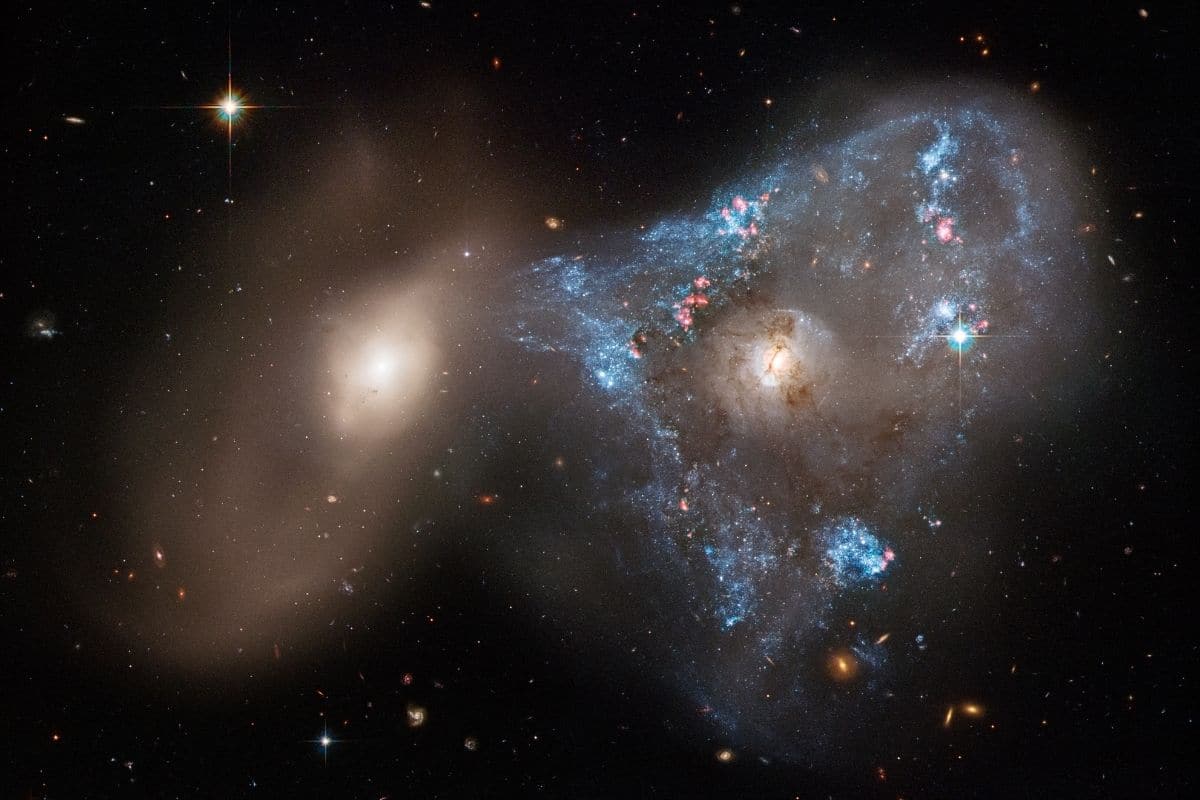

The Hubble Space Telescope has captured a spectacular head-on collision between two galaxies. And that produces a surprising picture.
Hubble Space Telescope has captured another breathtaking photo. For example, the telescope captured a special collision between two galaxies. The frontal slam created a conspicuous ‘space triangle’ made up of newly born stars.
ARP 143
In the image, the annular galaxy NGC 2445 (right) shows off along with its slightly less flashy companion NGC 2444 (left), a lenticular galaxy. The clashing duo are collectively referred to as ARP 143, located in the constellation Lynx.

Hubble photo of the clashing duo ARP 143. Left: NGC 2444, right: NGC 2445. Image: NASA, ESA, STScI, and J. Dalcanton (Center for Computational Astrophysics/Flatiron Inst., UWashington)
Astronomers say the two galaxies have become so entwined that it sparked a massive explosion of star formation in NGC 2445. Thousands of new stars are born there.
Stellar nursery
Incidentally, it is not uncommon for star formation to occur after a collision in the cores of galaxies. Because of such galactic encounters, a lot of gas – the raw material from which stars are born – flows towards the center. Also in this case, the heart of NGC 2445 is flooded with new stars by the supply of gas. What is exceptional is the bizarre triangular stellar nursery that has emerged.
blue and pink
Zooming in further, at the heart of NGC 2445 we find the youngest stars that are no older than one to two million years old. Hubble’s keen eye reveals some individual stars; the brightest and most massive in the galaxy. The brilliant blue ‘lumps’ are clusters of stars, while the pink color represents glowing clouds of gas enveloping young, massive star clusters.
filaments
Aside from the star formation in NGC 2445, another interesting feature Hubble has discovered is the dark filaments of gas in the galaxy’s bright core. The filaments may be formed by bursts of material. Using radio observations, astronomers have identified a powerful source at the heart of NGC 2445 that may be responsible for these eruptions. The radio source could have been created by intense star formation or a black hole that swallows material flowing toward the center.
Cosmic tug-of-war
Incidentally, NGC 2445 has not yet escaped the gravity of its partner on the left. The pair have become embroiled in a cosmic tug-of-war, which NGC 2444 appears to be winning. This galaxy ‘pulls’ gas from NGC 2445, resulting in the strange, triangular stellar nursery.
Meanwhile in NGC 2444
So while most of the action takes place in NGC 2445, that doesn’t mean the other member of the interacting pair escapes unscathed. The gravitational battle has also left its mark on NGC 2444, which has now stretched and taken on a somewhat odd shape. NGC 2444, by the way, only contains old stars, because it lost all its gas long ago, well before this galactic meeting.
Follow-up research
Astronomers find it very interesting to study young, massive star clusters that are still in their dust and gas cocoons. That’s because this kind of research could lead to a better understanding of how asteroid affects the evolution of galaxies. Research into ARP 143 is therefore continuing. The recently launched Webb telescope is intended to take a closer look at the colliding duo.
It’s over for Hubble now. Some areas in NGC 2445 are shrouded in dust, making it difficult for the space telescope to study it in visible light. However, using infrared observations, Webb will be able to peer through the dense dust. The intention is that Webb will eventually provide a complete count of the number of stars in NGC 2445. This count could then help astronomers answer pressing questions, including how quickly new stars are born and how long it takes for stars to fully form.
Source material:
†Hubble Looks at a ‘Space Triangle’ Spawned by a Galaxy Collision” – ESA Hubble
Image at the top of this article: NASA, ESA, STScI, and J. Dalcanton (Center for Computational Astrophysics/Flatiron Inst., UWashington)